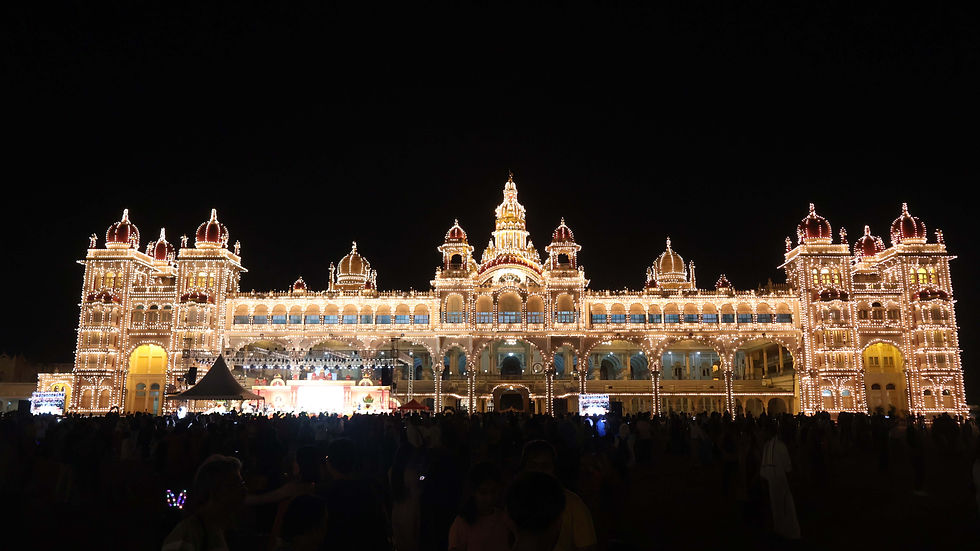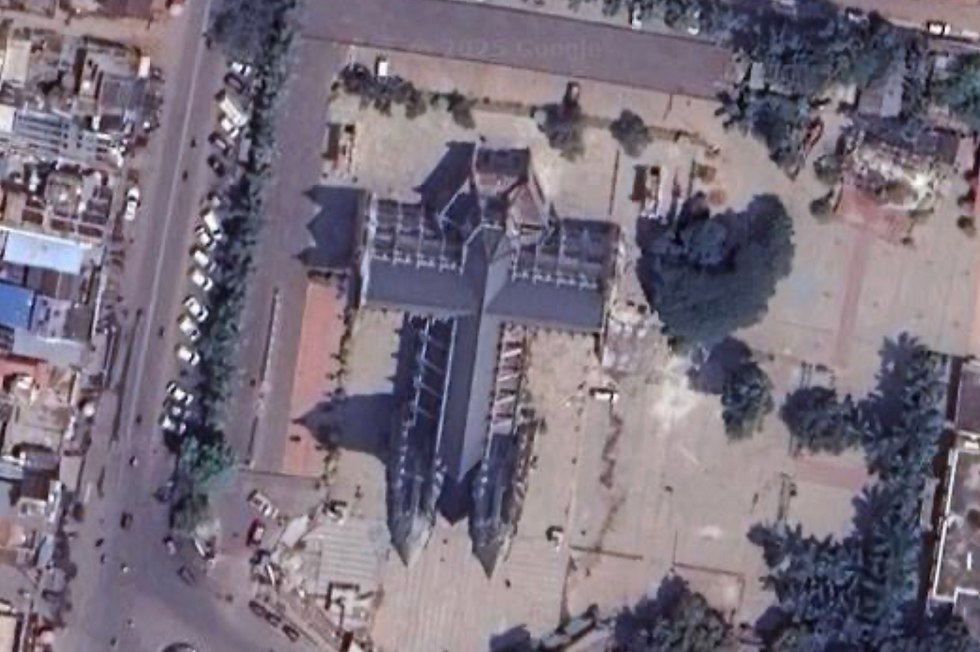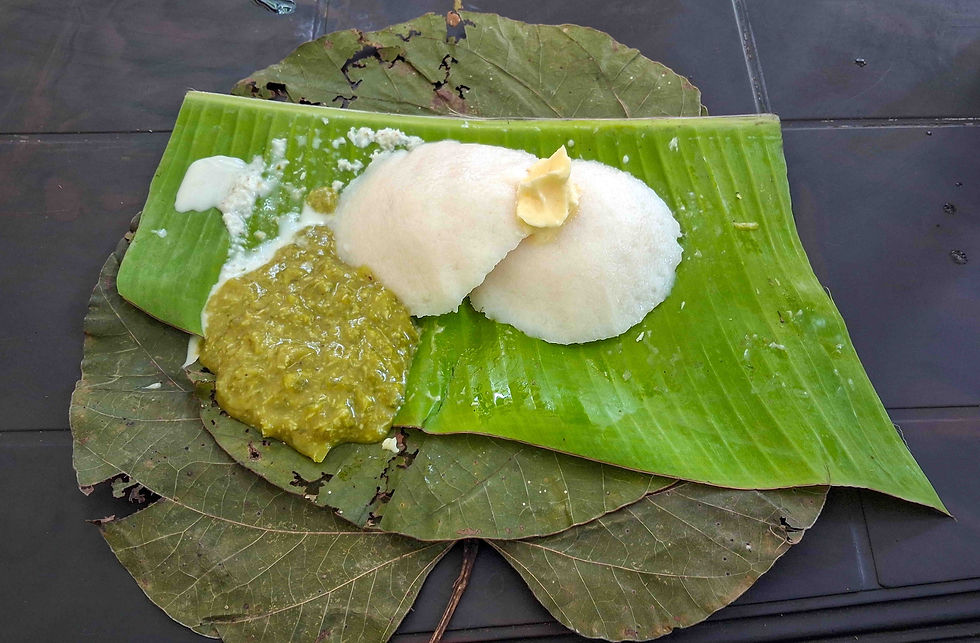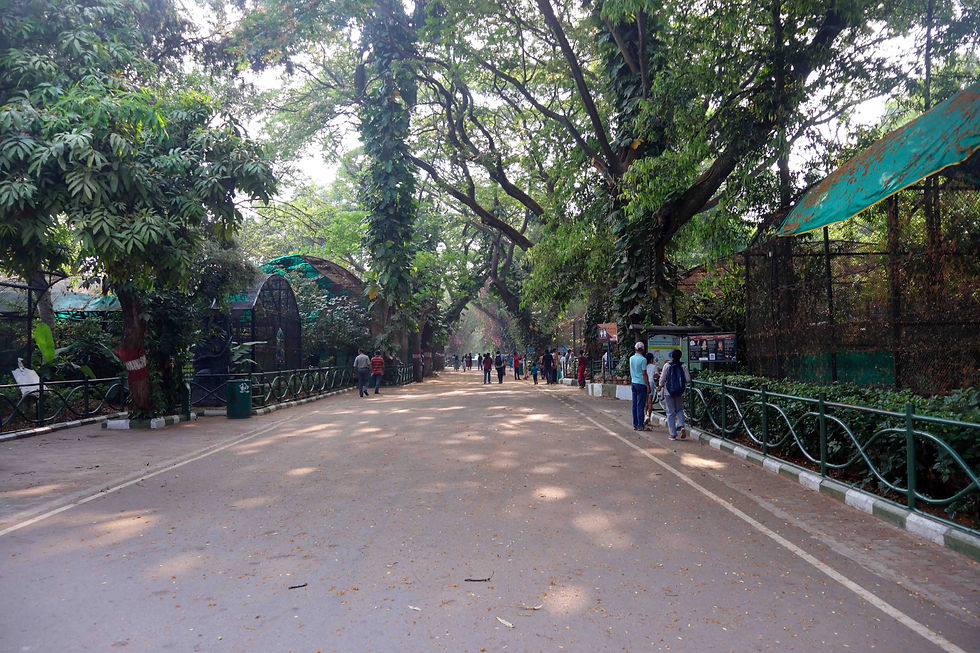A Royal Escape to Mysore
- Adrian David

- Mar 28
- 9 min read
They generally say that time and tide wait for none. Mysore, a heritage city in south India, says otherwise. Here, time comes to a standstill. The once royal kingdom is now a bustling city where every turn resounds with echoes of the past.

I knew I was in for an unforgettable adventure when I deboarded the train and got off at the Mysore Railway Station. Built in 1881, this historic station links the past with the present.

I stumbled upon a row of six striking sculptures capturing tourists in typical postures as I exited the railway station. Aptly called ‘Life is a Journey,’ the installation celebrates the spirit of travel.

Life gave me a meta moment when I clicked a statue of a male tourist holding a camera with my camera. Art reflected art.

The Kingdom of Mysore was ruled by the Wodeyar dynasty, with a total of around 21 generations of Maharajas ruling from 1399 to 1950. The kingdom was once a thriving state, renowned for its rich cultural heritage and architectural marvels, which still hold true today.
The statue of Maharaja Krishnaraja Wadiyar IV, the twenty-fourth maharaja of the Kingdom of Mysore, stands proudly at the city centre. A patron of the arts, he was once one of the world’s wealthiest men, with a personal fortune estimated in billions in today’s currency. Affectionately called as Nalwadi (which translates to ‘the fourth’ in the local language Kannada), he’s credited with modernizing Mysore into what it is today.

Mysore is also known as the ‘City of the Palaces’ owing to the seven palaces that adorn its cityscape. The most prominent one among them is the Mysore Palace, the historic royal residence of the Wadiyar dynasty. Along with the Taj Mahal, this is one of India’s most famous tourist attractions. Designed by the English architect Henry Irwin, the palace is built in the Indo-Saracenic architectural style, with Islamic, Rajput, and Gothic influences.

Every Sunday, the palace is lit up magnificently, truly a sight to behold. Tourists from across the globe flock together at this spot to experience the grand spectacle. It’s safe to say that it's worth visiting Mysore just to witness this alone.

The palace has four gateways, and the Jayamarthanda Gate located on the east of the palace is the grandest of them all. Standing under the night sky and gazing at this illuminated palace was a truly magical experience.

Around the palace, traditional tonga rides were being offered to give a glimpse into the past. As curious as I was to get on a two-wheeled cart drawn by a single horse, I decided against it out of pity for the poor animal.

Another defining symbol of Mysore is the St. Philomena's Cathedral, built in 1936 during the reign of Maharaja Krishnaraja Wadiyar IV. It’s so breathtaking that you could stand in front of it for minutes, simply taking in its beauty.

The church is dedicated to Saint Philomena, a young Greek princess who was martyred in the 4th century. Her relic is enshrined in a catacomb below the main altar.

The church was founded by French priest René Feuga, the first Bishop of Mysore, who belonged to the Missions Étrangères de Paris (MEP), commonly known as the Paris Foreign Mission Society.

Designed in the Neo Gothic architectural style, the cathedral is a replica of the Cologne Cathedral in Germany.

When viewed from above, its structure resembles a giant cross.

The main hall can accommodate up to 800 people and features stained glass windows depicting scenes from the life of Christ.
I attended the Sunday morning Mass in English and it was a blessed experience.

Mysore is world-renowned for three S’s, namely sweets, soaps, and silk.
Just type ‘Mysore’ on Google and Mysore Pak is bound to be the second search suggestion. The sweet is synonymous with the city and a must-try for anyone visiting.
The history behind the sweet is as fascinating as its taste. Maharaja Krishnaraja Wodeyar IV was a big-time foodie, and his palace had a large kitchen. In 1935, he ordered his chief chef, Kaksura Madappa, to create a new dessert for the royal family. Madappa experimented with ghee, gram flour, and sugar to create a hot fudge-like sweet, naming it Mysore Pak (paka means sweet concoction in Kannada).

When the king tasted the dessert, it melted in his mouth, eventually melting his heart. Needless to say, he loved it, and it soon became a royal favourite. Madappa opened a sweet shop, which eventually became Guru Sweet Mart, now run by his descendants, who have maintained a loyal following for almost 85 years, inheriting the original secret recipe.

After navigating the labyrinthine queue of eager customers, I finally scored a box of piping hot Mysore Pak, meticulously sliced into neat rectangular blocks.

The kind shopkeeper patiently walked me through the best way to enjoy the sweet, including microwaving instructions and tips on how to savour it over a period of time.

The moment I popped a Mysore Pak into my mouth, its velvety texture began to melt. With each bite, I couldn’t get enough of its sweet richness.

Yet another intrinsic product of Mysore is the world-renowned Mysore Sandal soap. Mysore used to be one of the world’s largest producers of sandalwood before it was overtaken by Australia in the past couple of decades.

Back in the day, Mysore exported its sandalwood to Europe. During World War I, large reserves of sandalwood were left unused due to export disruptions. Where others saw a challenge, Krishna Raja Wadiyar IV saw an opportunity. Along with his Prime Minister, Visvesvaraya, he set up the Government Soap Factory in 1916, which has been manufacturing this soap since then.

As I stepped into the factory outlet, the woody scent of sandalwood enveloped the air. After all, this soap is made from 100% pure sandalwood oil, a unique distinction. I bought some freshly crafted soaps, perhaps a bit generously, to take home and while showering with one, its rich fragrance lingered on me.

Next comes Mysore Silk. With a history spanning more than two centuries, Mysore silk sarees are renowned for their intricate designs and exquisite craftsmanship. Each saree is a work of art, reflecting the rich heritage of the region.

Mysore Pak is just one of the many delights the city has to offer to your palate. Mysore’s culinary landscape is vast with a vibrant range of traditional dishes that showcase its unique flavours. I set off on a food trail to discover the best spots in the city, starting with Hotel Mahadeshwara Mylari.

This legendary restaurant has been serving its signature Mylari Dosa since 1938. Mylari Dosa is a soft, fluffy dosa (a crepe made with rice) stuffed with potatoes and topped with a generous dollop of butter. The dish was good, and there are no two ways about it, but was it great? Not quite. It ticked all the right boxes, yet somehow fell short of being exceptional.

On the recommendation of a friendly local, I headed to Mylari Agrahara, which serves a better version than Mahadeswara Mylari. The humble restaurant offered a homely ambience, perfect for a traditional dining experience. Served on a banana leaf, the Mylari Dosa here was absolutely delicious in every sense of the word, and I’m not exaggerating when I say this is the best dosa I’ve tasted so far.

Their idlis (rice cakes) were equally as memorable, with a softness that made my fingers sink right into them.

My dosa quest continued at Gayatri Tiffin Room (GTR) where I tried their Benne Dosa. Benne means ‘butter’ in Kannada. Fried to perfection, the crispy dosa blended with the butter to make for a crave-worthy combo.

While Mysore has some amazing vegetarian dishes to relish, one mustn’t forget its fair share of non-vegetarian treats. I dropped by Hotel Hanumanthu, founded in 1930 and one of the oldest restaurants in the city. Their flagship offering is the mutton palav, an aromatic dish prepared with tender chunks of mutton, cumin rice, and a blend of spices.
The palav arrived at my table on a leaf plate, served steaming hot with raita (yogurt mixed with veggies), sherwa (mutton gravy), and a lemon slice. The flavours were spot on, and the dish truly lived up to the hype.

One more palav destination I tried was SGS Non Veg Gundu Palav, a restaurant founded by Gundumuneshwara (who lends his name to the outlet) and his wife in 1989. I ordered their Chicken Donne Palav, served in a traditional donne, a cup made from dried areca nut leaf. Each morsel of rice was richly infused with juicy chicken chunks, guaranteeing a sumptuous meal.

Exploring Mysore’s local cuisine wouldn’t be complete without a visit to Tegu Mess, a popular hole-in-the-wall eatery. Started in the 70s, this place has gained a loyal fan following for its meat dishes prepared with home-ground spices.
The menu left me spoilt for choice, but I finally settled on a plate of ghee rice paired with keema ball curry. The fragrant ghee rice mixed perfectly with the juicy meatballs. No wonder this place is packed with patrons round the clock. The service was the icing on the cake, with a warm waiter sporting a beaming smile who took the time to walk me through the menu.

It was a hot summer day, so I made my way to Brahmin Soda Factory, a juice bar founded in 1934. Despite having just two benches, the joint overflows with customers. You’re lucky if you find a seat here especially, during the sweltering afternoon heat.
I downed a glass of sarsaparilla soda and felt instantly refreshed. Sarsarapilla is a tropical root with medicinal properties that soothe the body and aid digestion.

In the evening, I stood outside the long queue at Usman Dry Gobi, which was much hyped by Instagram reels. The polite owner Usman asked us to wait as he expertly fried marinated cauliflower in a large wok sizzling with hot oil.

It took me almost thirty minutes before I was handed a plate of dry gobi. The crispy cauliflower coated in flavourful spices and served with mint chutney hit the spot, proving to be a delicious evening snack.

Being a nature lover, I spent the next morning at Karanji Lake, one of the oldest urban lakes of Mysore. It was built over a century ago as a percolation tank for the residents of Mysore for drinking, bathing, and washing, serving as a vital source of water for the city’s daily needs.

The lake houses a butterfly park and a walk-through aviary. There’s something soothing about being surrounded by lush greenery and the sweet songs of birds.


Along the path, I spotted some signboards warning me of crocodiles and snakes. Looks like my fitness tracker wasn’t the only thing tracking my every move.


The lake boat ride came as a tranquil escape. Since I was traveling solo, I waited a bit to find a partner. Once underway, I pedaled gently, gliding across the calm waters.

The Mysore Zoo is located right next to the lake park. Established in 1892 by Maharaja Chamaraja Wodeyar X, it was originally a private royal menagerie before opening to the public. Today, it’s considered India’s best zoo, housing over 1450 creatures from more than 168 species across 25 countries.

Strolling through the zoo awakened the inner child in me, flooding my mind with nostalgic memories of childhood visits. This time around, I was older enough to know better than to tease the caged animals.





The Royal Bengal Tiger gave me a death stare, looking right into my soul. Can’t blame him, it was lunchtime and he was hungry. Well, he’d be disappointed since I’m not exactly the plumpest target.

The scorching summer hadn’t spared the extremely thick-skinned crocodile either, and he was chilling in the pond. He swam closer, probably spotting the pair of Crocs I was wearing and mistaking it for his long-lost relative.

I stood behind the glass in front of the snake at the serpentarium, imagining the scene in Harry Potter where Harry speaks to the giant snake and the creature makes the glass disappear and escapes. Luckily, I’m not fluent in Parseltongue.

The blue-and-gold macaws reminded me of the bird from the animated flick Rio.

Some of the zoo inmates were kind enough to pose as I clicked them, clearly more camera-friendly than I am.



As twilight descended, I wandered through Devaraja Market, a vibrant weekly marketplace with a 140-year legacy. More than just a shopping destination, it's an immersive cultural experience. The marketplace has over a hundred colourful stalls selling heritage products, from spices to sandalwood products to silk saris.

The nearby Dufferin Clock Tower stands as a remnant of a bygone regal era. Built in 1886, it’s dedicated to the honour of Lord Dufferin, the Viceroy of British India who visited Mysore on the invitation of the then Maharaja. Among the locals, it’s also known as Chikkagadiyara, which translates to ‘little clock’ in Kannada.

Now I know why Karnataka Tourism’s tagline rightfully states One State, Many Worlds. Mysore is a world in itself. A world filled with grandeur and timeless charm. Its magic lingers with me long after I’ve left.
My visit has inspired me to explore more of India’s rich cultural heritage. This is just the beginning, there’s so much more to discover!



